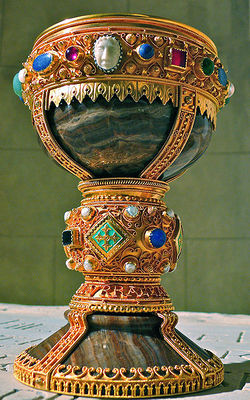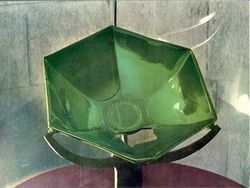Difference between revisions of "Category:Holy Grail (subject)"
| (3 intermediate revisions by the same user not shown) | |||
| Line 3: | Line 3: | ||
[[File:Grail Genoa.jpg|thumb|250px|The Genoa Basin]] | [[File:Grail Genoa.jpg|thumb|250px|The Genoa Basin]] | ||
*[[ | *[[Relics of Jesus|BACK to RELICS OF JESUS]] | ||
| Line 28: | Line 28: | ||
====The Antioch Chalice==== | ====The Antioch Chalice==== | ||
A chalice discovered in Antioch just before World War I (and | A chalice discovered in Antioch about 1910, just before World War I (and since 1950 in the Collections of the Metropolitan Museum of New York), was also touted for some time as the Holy Chalice. Swedish biologist turned archaeologist, Gustavius A. Eisen (1847-1940) published in 1923 a two-volume study of the chalice in which he strongly suggested that its unornamented inner cup, of silver, was the sacred relic and that its ornamented protective outer cup, depicting Christ and his disciples, was made between A.D. 50 and A.D. 70 by a craftsman who had seen the men and perhaps had copied some of them from life. Those conclusions were immediately dismissed by scholars. It is now recognized that the artifact is a 6th-century Byzantine lamp. | ||
==The Holy Grail, in literature & the arts== | ==The Holy Grail, in literature & the arts== | ||
Latest revision as of 04:38, 5 September 2018
According to Christian traditions, the Holy Grail is the dish, plate, or cup used by Jesus at the Last Supper, said to possess miraculous powers.
Overview
The legend of the Holy Grail first came together in the form of written romances, deriving perhaps from some pre-Christian Celtic folklore hints, in the later 12th and early 13th centuries. The connection of Joseph of Arimathea with the Grail legend dates from Robert de Boron's Joseph d'Arimathie (late 12th century) in which Joseph receives the Grail from an apparition of Jesus and sends it with his followers to Great Britain. The quest for the Holy Grail made up an important segment of the Arthurian cycle, appearing first in works by Chrétien de Troyes.
Lately, in arch-fi circles, the legend has taken new life, as the Holy Grail was connected with the secret of a Jesus Bloodline from his "wife" Mary Magdalene.
The Valencia Chalice
The most famous relic of the Holy Grail is the Holy Chalice, preserved at the Cathedral of Saint Mary, in Valencia [Spain]. The Chalice was supposedly taken by Peter to Rome in the first century, and then to Huesca in Spain by Saint Lawrence in the 3rd century, where it was protected by monks from Islamic invaders, before making its way to its current home. Archaeologists say the artifact is a 1st century Middle Eastern stone vessel, possibly from Antioch, Syria (now Turkey); its history can be traced to the 11th century, and it presently rests atop an ornate stem and base, made in the Medieval era of alabaster, gold, and gemstones. There is no proven connection with Jesus.
The León Chalice
Another chalice is preserved in the museum of the Cathedral of León, Spain. The Chalice was supposedly stolen from Jerusalem by Muslims, who gave it to the Christian community in Egypt. Centuries later, in around 1050 AD, it was sent as a gift to King Fernando I of Castile to thank him for sending aid during a famine. By that point, it had been concealed with opulent decorations of gold, pearls, emeralds, amethysts and sapphires. It was housed and used in the Basilica of San Isidoro at León, Spain, where it remained in storage until it was put on display in the museum which opened in the 1950s. The original artifact (an onyx chalice) may be a 1st century Middle Eastern stone vessel, but there is no proven connection with Jesus.
The Genoa Basin (the Sacro Catino)
Around 1101 the Genovese brought back from the Holy Land a dish they found in Caesarea Maritima. They paid a large sum of money as the dish was believed to be made of emerald. Jacobus de Voragine in his chronicle of Genoa, written at the close of the 13th century, claimed that it was the dish used by Jesus at the Last Supper. At such it was venerated in the Cathedral of Genoa. When Napoleon conquered Genoa in 1806, the dish was brought to France. It was returned in 1816 broken in 10 pieces (of which one was missing), which identified the emerald as glass. Restored in 1906 and 1951, the dish is now preserved at the Museum of the Treasure of the Cathedral of Genoa. The artifact is now recognized to be 9th-10th century work of Islamic art.
The Antioch Chalice
A chalice discovered in Antioch about 1910, just before World War I (and since 1950 in the Collections of the Metropolitan Museum of New York), was also touted for some time as the Holy Chalice. Swedish biologist turned archaeologist, Gustavius A. Eisen (1847-1940) published in 1923 a two-volume study of the chalice in which he strongly suggested that its unornamented inner cup, of silver, was the sacred relic and that its ornamented protective outer cup, depicting Christ and his disciples, was made between A.D. 50 and A.D. 70 by a craftsman who had seen the men and perhaps had copied some of them from life. Those conclusions were immediately dismissed by scholars. It is now recognized that the artifact is a 6th-century Byzantine lamp.
The Holy Grail, in literature & the arts
The legend of the Holy Grail has inspired numerous pieces of art and works of fiction. Lately, in arch-fi circles, the legend has taken new life, as the Holy Grail was connected with the secret of a Jesus Bloodline from his "wife" Mary Magdalene.
The Holy Grail, in scholarship
The legend of the Holy Grail have been studied in all its ramifications since the nineteenth century by philologists and specialists in folklore such as Frédéric Guillaume Bergmann, Eugène Hucher, and others, until the recent works by Richard W. Barber.
Related categories
External links
Pages in category "Holy Grail (subject)"
The following 13 pages are in this category, out of 13 total.
1
- The Damsel of the Sanct Grael (1857 Rossetti), art
- Studies on the Legend of the Holy Grail (1888 Nutt), book
- The Grail: From Celtic Myth to Christian Symbol (1963 Loomis), book
- Il Santo Graal = Holy Blood, Holy Grail (1982 @1982 Baigent, Leigh, Lincoln / Rambelli), arch-fi (Italian ed.)
- The Holy Grail (1992 Goodrich), book
- (+) The Woman with the Alabaster Jar (1993 Starbird), arch-fi
- Bloodline of the Holy Grail (1996 Gardner), arch-fi
- Genesis of the Grail Kings (1999 Gardner), arch-fi
2
- The Marian Conspiracy: The Hidden Truth about the Holy Grail, the Real Father of Christ, and the Tomb of the Virgin Mary (2000 Phillips), arch-fi book
- The Holy Grail: Imagination and Belief (2004 Barber), book
- The Real History behind the Da Vinci Code (2005 Newman), book
- The Grail Conspiracy (2005 Sholes, Moore), novel
- The Grail Enigma (2008 Gardner), arch-fi book
Media in category "Holy Grail (subject)"
The following 5 files are in this category, out of 5 total.
- 1952 * Costain (novel).jpg 357 × 499; 26 KB
- 1954 Saville (film).jpg 323 × 495; 79 KB
- 1962 Steedman (novel).jpg 345 × 499; 48 KB
- 1982 * Baigent (arch-fi).jpg 279 × 445; 24 KB
- 2003 * Brown (novel).jpg 279 × 498; 39 KB







